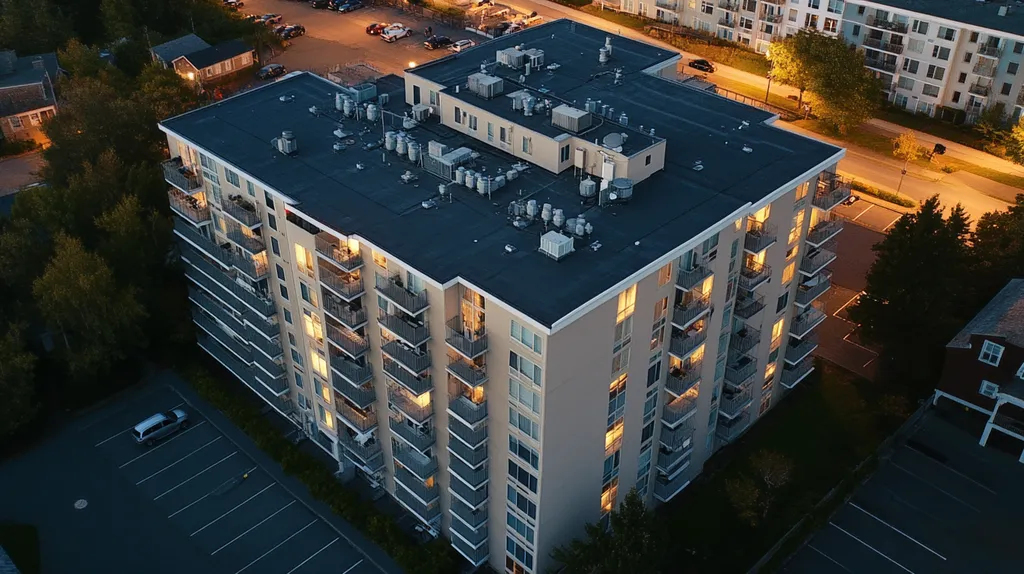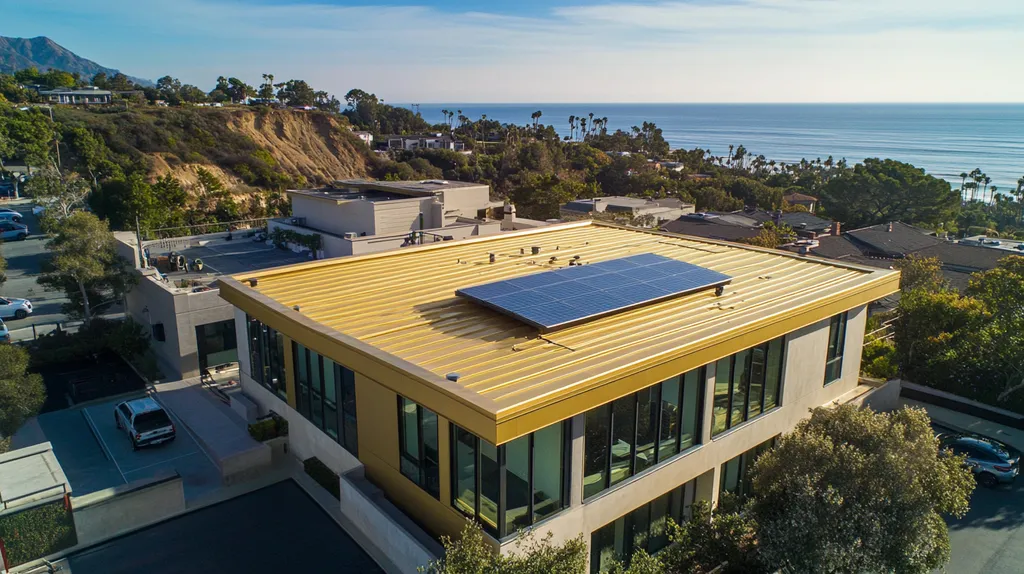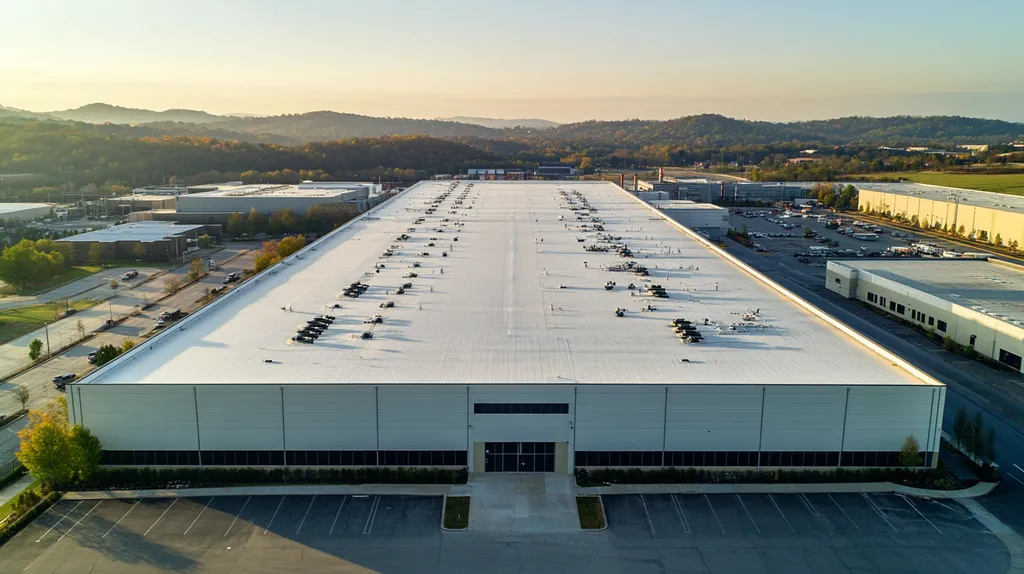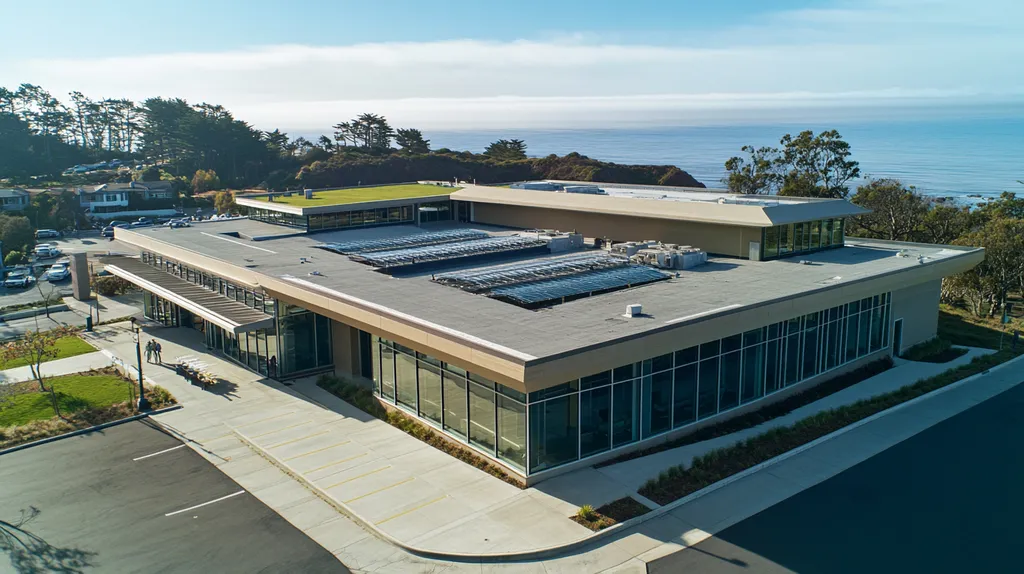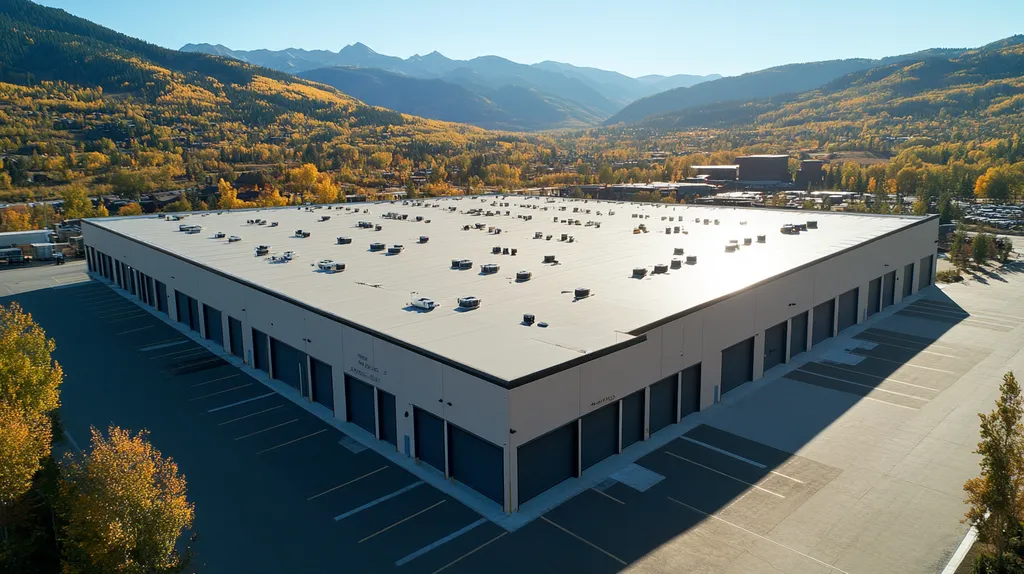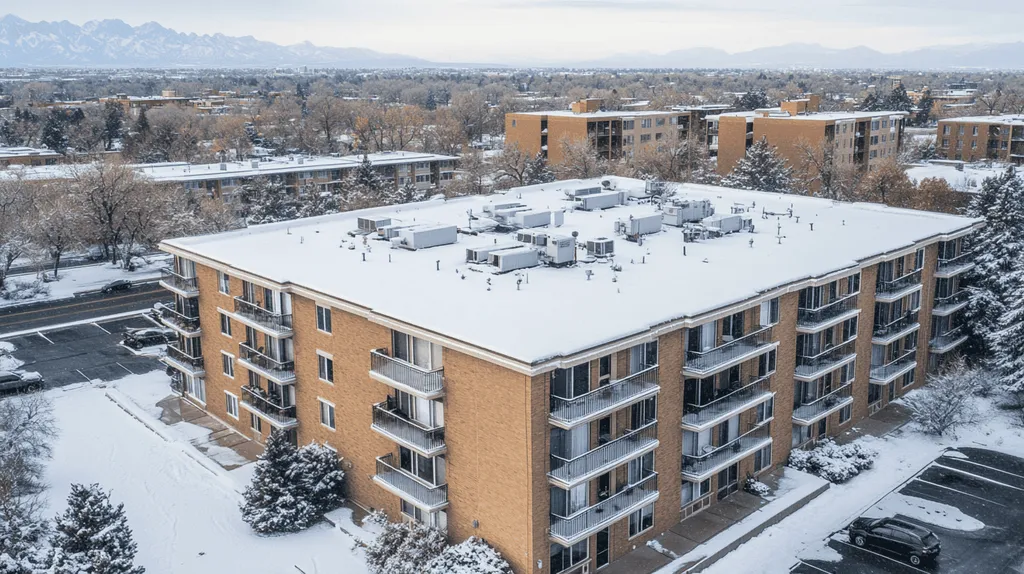Recent studies reveal that 40% of commercial roof failures stem from inadequate inspection methods, particularly in historical buildings where complex issues often go undetected.
Traditional assessment approaches frequently miss critical damage indicators, leading to premature roof failure and costly emergency repairs that could have been prevented.
This analysis examines the systemic flaws in current inspection practices, explores evidence-based alternatives, and presents solutions for implementing more effective evaluation methods to protect valuable commercial properties.
SECTION 1: CURRENT PRACTICES
As commercial roofs age, the importance of accurate damage assessments escalates significantly. A striking study indicates that nearly 40% of commercial roof failures arise from issues overlooked during inspections. Current methods, primarily visual inspections and standardized checklists, frequently miss critical damage, resulting in unnecessary repair costs and safety risks.
Visual Inspection Limitations
Visual inspections are the predominant method for evaluating roof conditions. However, they often fall short in uncovering problems that lurk beneath the surface. Various roofing materials can conceal serious issues, such as moisture infiltration or structural defects.
For example, a cursory visual inspection might fail to identify cracks in the underlayment or water accumulating underneath membrane layers. These hidden threats can worsen over time, causing extensive and costly damage if not addressed promptly.
By solely relying on visual observations, many inspectors overlook critical factors that influence a roof’s integrity, such as age, material deterioration, and environmental wear. This oversight can leave decision-makers with an incomplete understanding of their roof’s actual condition.
These limitations underscore the need for more comprehensive evaluation methods that incorporate advanced technology and specialized knowledge. Without such improvements, property owners may face severe repair needs and extensive roof failures.
Standardized Checklists and Oversights
Inspectors frequently utilize standardized checklists to facilitate the assessment process. While these checklists help streamline evaluations, they can inadvertently lead to important oversights. Many checklists tend to focus on generic indicators, missing unique variables that are not easily categorized.
For instance, while checklists often prioritize visible wear, they may disregard historical maintenance records that are crucial for understanding a roof’s performance. Ignoring such factors can render the roof susceptible to recurring issues.
Moreover, standard checklists usually fail to consider unique building characteristics and geographic conditions that significantly affect roof performance. When inspectors lean too heavily on checklist items, they may overlook the specific details that are vital for an accurate assessment.
Ultimately, a disproportionate reliance on checklists can foster a false sense of security, jeopardizing long-term property value and safety. Therefore, a more tailored assessment approach is essential for capturing the full scope of a roof’s condition.
Documentation Gaps in Current Methods
Thorough documentation is crucial for tracking a roof’s history and condition over time. Unfortunately, common inspection practices often exhibit significant gaps in record-keeping. This lack of detailed documentation can hinder informed decision-making regarding repairs or replacements.
For example, many inspections provide only brief notes or inadequate photographic records. This type of limited documentation fails to present a comprehensive view of the roof’s current state or historical context.
Additionally, these documentation deficiencies can increase liability for property owners. If damage occurs, insufficient records may complicate insurance claims or warranty processes.
To enhance documentation practices, implementing advanced technology, such as drone inspections and comprehensive reporting systems, can effectively address these shortcomings. A robust documentation process not only supports informed decision-making but also helps safeguard the roof’s integrity.
SECTION 2: SYSTEMIC ISSUES
The need for rigorous commercial roof inspections is paramount, especially for historical buildings facing unique challenges. Failing to identify roof damage can result in catastrophic consequences like structural failure and exorbitant repair expenses. Unfortunately, many inspectors enter the field with insufficient training, and inconsistencies in inspection protocols leave property owners exposed to significant risks.
Inadequate Training for Inspectors
A wide disparity in the expertise of roof inspectors leads to inconsistent assessments of roofing conditions. This lack of standardized training often means that specific damage indicators, particularly in older structures, go unnoticed. Understanding historical architectural styles and the materials used is essential for accurate inspections, yet many inspectors fall short.
For instance, older roofs frequently exhibit issues with the deterioration of flashing materials. An inspector unfamiliar with these historical characteristics may overlook critical signs, which can ultimately result in costly water damage. This training gap not only affects the quality of inspections but also hazards the long-term integrity of the buildings being assessed.
Additionally, many inspectors lack familiarity with modern tools that can enhance assessments. Technologies such as infrared cameras and moisture meters are vital; they can reveal hidden issues invisible to the naked eye. Without adequate training, inspectors are unable to leverage these technologies effectively, which increases the likelihood of costly oversights.
The clear conclusion is that enhancing inspector training is crucial to minimizing potential errors and protecting property owners from unanticipated repair needs.
Lack of Consistency in Inspection Protocols
Inconsistent inspection protocols represent a significant challenge in the evaluation of commercial roofs. Inspectors often apply different methods and checklists, resulting in varying assessments. This lack of uniformity can hinder effective analysis, particularly for historical roofs, which often have unique features requiring specialized attention.
For example, one inspector may only consider visible conditions, while another digs deeper into structural integrity. Such inconsistencies can confuse property owners, leaving them uncertain about their roofs’ true conditions and consequently affecting their decision-making.
Moreover, the absence of clearly defined industry standards exacerbates the challenges involved in assessments. Without a unified framework, inspectors risk prioritizing issues based on subjective judgment rather than a systematic approach. This can prevent critical concerns from being identified and resolved, allowing significant damage to develop unnoticed.
To improve regulatory compliance and enhance credibility within the roofing industry, establishing standardized inspection protocols is essential. Uniform practices can lead to more comprehensive evaluations, ensuring that property owners receive accurate and actionable assessments of their roofs.
Overreliance on Visual Assessments
While visual assessments are commonplace in roof inspections, they carry inherent limitations. Although the human eye can detect many obvious issues, it often fails to uncover hidden damage, particularly in older roofs. Relying exclusively on visual evaluations can place property owners at increased risk.
Many structural problems, such as wood rot or delaminated roofing materials, might not become apparent until they reach critical levels. An inspector could deem a roof condition acceptable, only for property owners to find leaks and deterioration shortly after. This oversight can lead to emergency repairs that were easily preventable with more thorough inspection methods.
Furthermore, cognitive biases may influence inspectors during visual evaluations, causing them to misjudge the severity of potential problems. A seemingly intact roof may still conceal serious underlying issues, detectable only through advanced inspection techniques.
Recognizing these limitations underscores the importance of integrating technology into the inspection process. Employing moisture detection tools and thermal imaging can enhance the accuracy of assessments, moving beyond a purely visual focus to better protect property owners against critical yet unnoticed damage.
SECTION 3: MISSED OPPORTUNITIES
Inaccurate assessments during roof inspections can have dire consequences for commercial properties. Research reveals that over 60% of roof failures stem from neglected issues, such as moisture infiltration and structural vulnerabilities. Companies risk incurring hefty repair costs or premature roof replacements by failing to identify critical components during inspections. This section explores overlooked aspects that can hinder effective damage assessments, shedding light on areas in need of urgent improvement.
Neglecting Hidden Moisture Issues
Hidden moisture poses a significant threat to commercial roofs, often eluding detection during standard inspections. Traditional assessment methods typically focus on visible damage, overlooking subtle signs of moisture buildup. Trapped moisture beneath roofing materials can lead to mold growth and weaken structural integrity over time.
Building materials like insulation absorb moisture, diminishing their effectiveness and increasing deterioration risks. For example, modified bitumen roofs can conceal moisture until serious damage occurs. This highlights the necessity for advanced moisture detection techniques that can identify risks before they escalate.
Implementing advanced moisture scanning technology can provide valuable insights into a roof’s condition. By utilizing these methods, facility managers can uncover at-risk areas before they develop into serious issues. Prioritizing inspections that incorporate modern moisture detection will benefit property owners immensely.
Effectively addressing hidden moisture problems not only saves on costly repairs but also extends the life of roofing systems. Ignoring this critical aspect can lead to health hazards and significant financial losses for property owners.
Overlooking Roof Penetrations and Flashing
Roof penetrations and flashing are often the weakest links in a commercial roofing system, yet they frequently receive insufficient attention during inspections. A lack of thorough assessments in these areas can leave vulnerabilities unnoticed, leading to leaks and structural damage.
Defective flashing around HVAC units or vent pipes can permit water to infiltrate a building’s interior, resulting in extensive damage over time. When inspections overlook these critical elements, the integrity of the entire roofing system is compromised.
Moreover, flashing materials are susceptible to deterioration and should be regularly maintained. Inspectors must check for rust, cracks, or missing materials to avoid long-term repair costs. This proactive approach ensures that potential issues are caught early.
With advanced tools, inspectors can now assess the condition of roof penetrations more accurately than ever. Investing in detailed evaluations of these vital areas is crucial for preserving the roof’s overall structural integrity.
Ignoring Structural Weaknesses
Neglecting structural weaknesses during roof inspections can lead to catastrophic consequences, particularly in older or historically significant buildings. A compromised roof not only endangers the safety of occupants but may also incur exorbitant renovation costs or legal liabilities.
Indicators such as sagging beams or deteriorated rafters often signal underlying problems that require immediate attention. Inspectors should evaluate not only the roofing materials but also the supporting structures essential for carrying the roof’s load.
Failing to assess structural components can trigger a domino effect, where minor concerns escalate into major failures. For instance, if structural elements weaken due to water damage, they can ultimately lead to roof collapse.
Integrating a comprehensive structural evaluation into the inspection process helps identify and address weaknesses promptly. This proactive approach can significantly extend the lifespan of the entire roofing system and safeguard against potential hazards.
SECTION 4: ROOT CAUSES
Identifying the root causes of roof damage is vital for effective risk management. Property owners often encounter significant challenges due to insufficient maintenance, ineffective warranty compliance, and budgetary constraints. When historical commercial roofs are neglected, the consequences can be severe, threatening the structural integrity of the entire building. Addressing these root causes is essential to ensure accurate damage assessments and long-term sustainability.
Insufficient Maintenance Requirements
Insufficient maintenance is a major threat to the longevity of commercial roofs. Many property owners underestimate the necessity of regular inspections and upkeep. Without a systematic maintenance plan, minor problems can snowball into costly repairs.
For example, roofs that lack routine inspections may develop unnoticed leaks. Over time, these leaks can create water damage severe enough to compromise the entire roof structure. Neglecting simple maintenance tasks can transition manageable issues into expensive renovations.
It is recommended to conduct inspections at least bi-annually. Adhering to this standard significantly extends a roof’s lifespan and reduces overall maintenance costs. Ignoring regular maintenance is a false economy, often resulting in larger financial burdens down the line.
Additionally, historical buildings often have unique maintenance requirements that need special attention. Recognizing these specific needs can prevent exacerbation of existing problems and save property owners from substantial future expenses.
Ineffective Warranty Compliance
Warranties are critical for supporting the longevity of roofing systems, yet many property owners fail to comply with their terms. Many warranties stipulate specific maintenance actions to remain valid, but these requirements are frequently overlooked.
If property owners do not adhere to warranty stipulations, they risk incurring repair costs that should otherwise be covered. For instance, if a manufacturer discovers a lack of proper maintenance, they may deny warranty claims, leaving property owners liable for significant expenditures.
This scenario highlights the necessity of understanding warranty conditions and compliance. Property owners should familiarize themselves with the maintenance protocols outlined in their warranties to avoid financial pitfalls. Lapses in compliance can result in costly repercussions.
Training facility managers on warranty requirements is crucial. Keeping up-to-date maintenance logs and regularly conducting inspections following the manufacturer’s guidelines can significantly reduce risks associated with non-compliance.
Budget Constraints and Prioritization
Budget constraints often influence maintenance decisions, affecting roofing systems specifically. For many property owners, allocating adequate funds for roofing maintenance can be challenging, leading to the prioritization of more immediate concerns at the expense of essential repairs.
When budget decisions systematically ignore roof maintenance, the long-term consequences can be severe. For example, delaying roof repairs can lead to severe water damage, necessitating costly internal renovations that could have been avoided. Such financial implications underscore the need for informed budget allocation.
Investing in preventive maintenance is a cost-effective strategy over time. A well-maintained roof reduces the chances of unexpected repairs and prolongs the roof system’s lifespan. Property managers must prioritize roofing investments to ensure long-term savings and sustainability.
Ultimately, it is crucial to create a dedicated budget for roofing inspections, maintenance, and repairs. By addressing these budgetary constraints, property owners can secure the ongoing health of their commercial roofs, aligning with wider sustainability goals.
DATA DRIVEN EVIDENCE
Inadequate roof inspections can lead to severe consequences for commercial properties, including costly emergency repairs and operational downtime. Studies indicate that up to 30% of roof inspections fail to identify critical damage. These oversights can disrupt business operations and lead to financial strain. This section examines alarming statistics regarding inspection failures, presents case studies of undetected damage, and discusses the financial implications stemming from insufficient inspections.
Statistical Analysis of Inspection Failures
A troubling number of roof inspections fall short of their intended purpose. Research shows that nearly one-third of commercial roofs possess damage that remains undetected during standard assessments. This problem primarily stems from an over-reliance on visual inspections, which often fail to uncover underlying structural issues.
Moreover, many inspectors do not utilize contemporary data analytics to enhance inspection outcomes. Instead, they frequently rely on outdated practices that overlook latent vulnerabilities within the roof structure.
The consequences of these undetected damages extend beyond immediate repair needs. Property owners can experience heightened insurance premiums and diminished property values due to unresolved roofing concerns. The financial implications can linger long after an inspection, making comprehensive evaluation methods crucial for effective property management.
These statistics emphasize the urgent need for a paradigm shift in inspection methodologies. By modernizing techniques, organizations can drastically reduce failure rates and protect valuable investments.
Case Studies of Undetected Damage
Recent examples underscore the hazards of conventional inspection practices. One commercial property, after undergoing a routine inspection, experienced a major roof failure during winter. Inspectors had overlooked critical signs of water damage, which were hidden from surface view.
In another case, a manufacturing facility faced significant mold growth and equipment damage from a leaking roof. Despite an initial inspection reporting no issues, data analysis later confirmed that the leaks had existed for months. Both incidents reveal a disconnect between standard inspection practices and the actual condition of the roofs.
These failures are more common than one might assume. Across various sectors, property managers consistently report experiences where undetected damage resulted in substantial structural challenges. The financial fallout has prompted many stakeholders to rethink inspection processes and the types of data utilized.
These real-world examples highlight the critical necessity for accurate damage assessments. Improved inspection techniques can help property owners minimize risks and extend the lifespan of their roofing systems.
Cost Implications of Inadequate Inspections
The financial ramifications of undetected roof damage are staggering. A small, overlooked issue can escalate into repair costs ranging in the six figures within just a few years. This figure does not even encompass potential operational disruptions that can significantly impact productivity.
Additionally, the long-term ramifications of inadequate inspections can burden budgets with unplanned maintenance. Property owners may find themselves managing emergency repairs and inconsistent roofing solutions that fail to address the root issues.
Furthermore, businesses may suffer revenue losses due to damaged inventory or production delays caused by roof failures. The initial cost savings from a low-price inspection can quickly diminish if essential repairs are left unaddressed.
In summary, the expenses associated with insufficient inspection methods often surpass what is needed for in-depth evaluations. A more informed, data-driven approach can minimize future costs and safeguard commercial assets (source: Roof River City).
SECTION 6: ALTERNATIVE SOLUTIONS
Enhancing inspection methods for historical commercial roofs is crucial for reducing long-term maintenance costs and preserving structural integrity. Conventional assessment techniques often fail to identify vital indicators of roof health, leading to expensive repairs or premature replacements. As property owners face mounting pressure to maintain their roofs effectively, exploring innovative solutions is essential. This section outlines advanced technologies, integrated methodologies, and improved documentation practices to upgrade roof assessment procedures.
Implementing Advanced Inspection Technologies
The adoption of advanced technologies like drone inspections and thermal imaging can transform the evaluation of historical roofs. Drones equipped with high-resolution cameras provide expansive aerial views, allowing inspectors to detect damage from previously hard-to-reach angles. Thermal imaging, on the other hand, identifies temperature discrepancies that may signal moisture issues hidden beneath the roofing material.
By embracing these technologies, property owners can enhance their understanding of roof health while minimizing safety risks for workers. Drones can efficiently cover large areas, significantly reducing inspection times and increasing precision. This proactive approach enables maintenance teams to tackle emerging issues before they escalate into major concerns.
Additionally, these tools facilitate comprehensive data collection for trend analysis. With high-quality aerial images and thermal data on hand, facility managers can make more strategic decisions about roof maintenance schedules. Consequently, advanced inspection technologies support effective long-term management of historical buildings.
Integrated Multi-Method Inspection Approaches
Relying solely on one inspection strategy often results in incomplete evaluations. An integrated methodology that combines visual inspections, physical assessments, and advanced technologies yields a holistic picture of a roof’s condition. Each technique contributes unique insights that, when amalgamated, create a clearer understanding of potential issues.
For example, coupling visual inspections with moisture meters can identify troublesome areas that might otherwise be overlooked. While visual assessments reveal visible damage, moisture detection tools can uncover leaks that have already caused damage beneath the surface.
This comprehensive approach enhances assessment accuracy and streamlines repair processes. By identifying the precise condition of the roof, property owners can prioritize repairs according to urgency and budgetary constraints. In the long run, this strategy helps maintain the roof’s structural integrity over time.
Enhanced Documentation and Reporting Standards
Effective communication of inspection results is vital for informed decision-making. Standardizing documentation and reporting ensures clarity and consistency in conveying roof conditions to stakeholders. Doing so helps prevent misunderstandings that may stem from vague or incomplete reports.
Utilizing a uniform template for inspection reports can improve organization and enhance the clarity of findings. Reports that incorporate standardized photographs, detailed assessments, and clear recommendations become invaluable resources for property owners, facilitating the tracking of changes over time.
Moreover, meticulous documentation plays a crucial role in compliance with regulatory requirements and insurance matters. Maintaining thorough records of inspections and maintenance is essential for protecting investments. By ensuring comprehensive and standardized reporting, property owners can fulfill legal obligations and support strategic planning for roof maintenance and financial decisions.
Looking Ahead
Industry data reveals that 40% of commercial roof failures stem directly from inadequate inspection practices, with historical buildings facing particularly devastating consequences.
The financial impact of these oversights often exceeds $100,000 per incident, not including business interruption costs and potential structural damage.
As building technology evolves, property owners must transition from outdated visual assessments to comprehensive, technology-driven inspection protocols that incorporate thermal imaging, moisture mapping, and drone surveillance.
Implementation of standardized documentation practices, coupled with advanced inspection methodologies, will significantly reduce failure rates while protecting valuable commercial assets.
The roofing industry stands at a critical juncture where embracing these changes is no longer optional but essential for protecting historical commercial properties.
FREQUENTLY ASKED QUESTIONS
Q. What are the limitations of visual inspections for commercial roofs?
A. Visual inspections often miss hidden damage beneath the surface, leading to serious issues. Many roofing materials, especially older ones, can conceal cracks, moisture infiltration, or structural defects. As a result, reliance solely on visual assessments can overlook critical factors affecting a roof’s health and longevity.
Q. How does inspector training affect commercial roof assessments?
A. Insufficient training among inspectors can lead to inconsistencies in evaluating roof conditions. Many inspectors may overlook specific indicators of damage, particularly in older roofs, resulting in costly misdiagnoses. Enhanced training is crucial to ensure accurate assessments and to protect property owners from unexpected repair needs.
Q. What hidden issues do inspections often neglect in commercial roofs?
A. Inspections frequently overlook hidden moisture problems, which can lead to mold growth and structural weakening. Areas such as roof penetrations and flashing also require thorough assessments, as they can be vulnerable to leaks. Addressing these issues during inspections is vital to prevent long-term damage and high repair costs.
Q. How can insufficient maintenance affect a commercial roof?
A. Insufficient maintenance can lead to significant repair costs as minor issues escalate. Regular inspections and upkeep help identify potential problems before they worsen, ultimately preserving a roof’s integrity. Failing to maintain roofs often results in emergencies that could have been prevented, particularly for historical structures with unique needs.
Q. What are the financial impacts of undetected roof damage?
A. Undetected roof damage can lead to expensive repairs and operational disruptions. Statistics show that one-third of roofs have undetected damage that can result in unexpected costs for property owners. Proactive inspections and modern assessment methods are essential to mitigate these financial repercussions and ensure effective property management.
Q. What innovative solutions can improve commercial roof inspections?
A. Implementing advanced inspection technologies, such as drones and thermal imaging, can significantly enhance evaluations. Additionally, integrating multiple inspection methods and improving documentation processes can yield a comprehensive understanding of roof conditions. These innovations help identify issues early, extending the life of commercial roofing systems.
Q. How do weather conditions affect commercial roof inspections?
A. Weather conditions can greatly affect the accuracy of commercial roof inspections. Rain or snow can hide existing damage, making it difficult to assess the roof properly. Additionally, extreme temperatures can cause materials to expand or contract, further complicating evaluations. Scheduling inspections during favorable weather conditions is crucial for thorough assessments.

